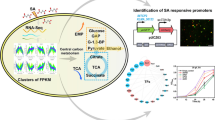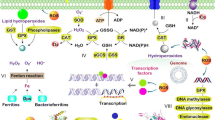Abstract
A large number of two-component signal transduction systems (TCSTS) including 59 putative sensory histidine kinases (HK) and 55 response regulators (RR) were identified from the Desulfovibrio vulgaris genome. In this study, the structural and phylogenetic analyses of all putative TCSTSs in D. vulgaris were performed. The results showed that D. vulgaris contained 21 hybrid-type HKs, implying that multiple-step phosphorelay may be a common signal transduction mechanism in D. vulgaris. Despite the low sequence similarity that restricted the resolution of the phylogenetic analyses, most TCSTS components of D. vulgaris were found clustered into several subfamilies previously recognized in Escherichia coli and Bacillus subtilis. An attempt was made in this investigation to identify the possible cognate HK-RR pairs not linked on the chromosome in D. vulgaris based on similar expression patterns in response to various environmental and genetic changes. Expression levels of all HK and RR genes were measured using whole-genome microarrays. Five groups of HK-RR genes not linked on the chromosome were identified as possible cognate pairs in D. vulgaris. The results provided a preliminary list of possible cognate HK-RR pairs and constitute a basis for further exploration of interaction and physiological function of TCSTSs in D. vulgaris.






Similar content being viewed by others
References
Ali RW, Skaug N, Nilsen R, Bakken V (1994) Microbial associations of 4 putative periodontal pathogens in Sudanese adult periodontitis patients determined by DNA probe analysis. J Periodontol 65:1053–1057
Appleby JL, Parkinson JS, Bourret RB (1996) Signal transduction via the multi-step phosphorelay: not necessarily a road less traveled. Cell 86:845–848
Aravind L, Koonin EV (1998) The HD domain defines a new superfamily of metal-dependent phosphohydrolases. Trends Biochem Sci 23:469–472
Aravind L, Ponting CP (1997) The GAF domain: an evolutionary link between diverse phototransducing proteins. Trends Biochem Sci 22:458–459
Aravind L, Ponting CP (1999) The cytoplasmic helical linker domain of receptor histidine kinase and methyl-accepting proteins is common to many prokaryotic signaling proteins. FEMS Microbiol Lett 176:111–116
Bork P, Brown NP, Hegyi H, Schultz J (1996) The protein phosphatase 2C (PP2C) superfamily: detection of bacterial homologues. Protein Sci 5:1421–1425
Catlett NL, Yoder OC, Turgeon BG (2003) Whole-genome analysis of two-component signal transduction genes in fungal pathogens. Eukaryot Cell 2:1151–1161
Darwin AJ, Ziegelhoffer EC, Kiley PJ, Stewart V (1998) Fnr, NarP, and NarL regulation of Escherichia coli K-12 napF (periplasmic nitrate reductase) operon transcription in vitro. J Bacteriol 180:4192–4198
Dolla A, Pohorelic BK, Voordouw JK, Voordouw G (2000) Deletion of the hmc operon of Desulfovibrio vulgaris subsp. vulgaris Hildenborough hampers hydrogen metabolism and low-redox-potential niche establishment. Arch Microbiol 174:143–151
Dutta R, Qin L, Inouye M (1999) Histidine kinases: diversity of domain organization. Mol Microbiol 34:633–640
Egger LA, Park H, Inouye M (1997) Signal transduction via the histidyl-aspartyl phosphorelay. Genes Cells 2:167–184
Fabret C, Hoch JA (1998) A two-component signal transduction system essential for growth of Bacillus subtilis: implications for anti-infective therapy. J Bacteriol 180:6375–6583
Fryxell KJ (1996) The coevolution of gene family trees. Trends Genet 12:364–369
Haveman SA, Brunelle V, Voordouw JK, Voordouw G, Heidelberg JF, Rabus R (2003) Gene expression analysis of energy metabolism mutants of Desulfovibrio vulgaris Hildenborough indicates an important role for alcohol dehydrogenase. J Bacteriol 185:4345–4355
Heidelberg JF, Seshadri R, Haveman SA, Hemme CL, Paulsen IT, Kolonay JF, Eisen JA, Ward N, Methe B, Brinkac LM, Daugherty SC, Deboy RT, Dodson RJ, Durkin AS, Madupu R, Nelson WC, Sullivan SA, Fouts D, Haft DH, Selengut J, Peterson JD, Davidsen TM, Zafar N, Zhou L, Radune D, Dimitrov G, Hance M, Tran K, Khouri H, Gill J, Utterback TR, Feldblyum TV, Wall JD, Voordouw G, Fraser CM (2004) The genome sequence of the anaerobic, sulfate-reducing bacterium Desulfovibrio vulgaris Hildenborough. Nat Biotechnol 22:554–559
Hoch JA (2000) Two-component and phosphorelay signal transduction. Curr Opin Microbiol 3:165–170
Island MD, Wei BY, Kadner RJ (1992) Structure and function of the uhp genes for the sugar phosphate transport system in Escherichia coli and Salmonella typhimurium. J Bacteriol 174:2754–2762
Jenkins LS, Nunn WD (1987) Genetic and molecular characterization of the genes involved in short-chain fatty acid degradation in Escherichia coli: the ato system. J Bacteriol 169:42–52
Kato M, Mizuno T, Shimizu T, Hakoshima T (1997) Insights into multistep phosphorelay from the crystal structure of the C-terminal HPt domain of ArcB. Cell 88:717–723
Keon RG, Fu R, Voordouw G (1997) Deletion of two downstream genes alters expression of the hmc operon of Desulfovibrio vulgaris subsp vulgaris Hildenborough. Arch Microbiol 167:376–383
King JK, Kostka JE, Frischer ME, Saunders FM (2000) Sulfate-reducing bacteria methylate mercury at variable rates in pure culture and in marine sediments. Appl Environ Microbiol 66:2430–2437
Kobayashi K, Ogura M, Yamaguchi H, Yoshida K, Ogasawara N, Tanaka T, Fujita Y (2001) Comprehensive DNA microarray analysis of Bacillus subtilis two-component regulatory systems. J Bacteriol 183:7365–7370
Koretke KK, Lupas AN, Warren PV, Rosenberg M, Brown JR (2000) Evolution of two-component signal transduction. Mol Biol Evol 17:1956–1970
Letunic I, Goodstadt L, Dickens NJ, Doerks T, Schultz J, Mott R, Ciccarelli F, Copley RR, Ponting CP, Bork P (2002) Recent improvements to the SMART domain-based sequence annotation resource. Nucleic Acids Res 30:242–244
Lyristis M, Bryant AE, Sloan J, Awad MM, Nisbet IT, Stevens DL, Rood JI (1994) Identification and molecular analysis of a locus that regulates extracellular toxin production in Clostridium perfringens. Mol Microbiol 12:761–777
Martin-Galiano AJ, Wells JM, de la Campa AG (2004) Relationship between codon biased genes, microarray expression values and physiological characteristics of Streptococcus pneumoniae. Microbiology 150:2313–2325
McFarland N, McCarter L, Artz S, Kustu S (1981) Nitrogen regulatory locus “glnR” of enteric bacteria is composed of cistrons ntrB and ntrC: identification of their protein products. Proc Natl Acad Sci USA 78:2135–2139
Nakano MM, Zuber P, Glaser P, Danchin A, Hulett FM (1996) Two-component regulatory proteins ResD-ResE are required for transcriptional activation of fnr upon oxygen limitation in Bacillus subtilis. J Bacteriol 178:3796–3802
Neuwald AF, Aravind L, Spouge JL, Koonin EV (1999) AAA+: A class of chaperone-like ATPases associated with the assembly, operation, and disassembly of protein complexes. Genome Res 9:27–43
Nuwaysir EF, Huang W, Albert TJ, Singh J, Nuwaysir K, Pitas A, Richmond T, Gorski T, Berg JP, Ballin J, McCormick M, Norton J, Pollock T, Sumwalt T, Butcher L, Porter D, Molla M, Hall C, Blattner F, Sussman MR, Wallace RL, Cerrina F, Green RD (2002) Gene expression analysis using oligonucleotide arrays produced by maskless photolithography. Genome Res 12:1749–1755
Oka A, Sakai H, Iwakoshi S (2002) His-Asp phosphorelay signal transduction in higher plants: receptors and response regulators for cytokinin signaling in Arabidopsis thaliana. Genes Genet Syst 77:383–391
Oshima T, Aiba H, Masuda Y, Kanaya S, Sugiura M, Wanner BL, Mori H, Mizuno T (2002) Transcriptome analysis of all two-component regulatory system mutants of Escherichia coli K-12. Mol Microbiol 46:281–291
Quon KC, Marczynski GT, Shapiro L (1996) Cell cycle control by an essential bacterial two-component signal transduction protein. Cell 84:83–93
Rodrigue A, Quentin Y, Lazdunski A, Mejean V, Foglino M (2000) Two-component systems in Pseudomonas aeruginosa: why so many? Trends Microbiol 8:498–504
Saitou N, Nei M (1987) The neighbor-joining method: a new method for reconstructing phylogenetic trees. Mol Biol Evol 4:406–425
Sitnikov DM, Schineller JB, Baldwin TO (1995) Transcriptional regulation of bioluminesence genes from Vibrio fischeri. Mol Microbiol 17:801–812
Slater H, Alvarez-Morales A, Barber CE, Daniels MJ, Dow JM (2000) A two-component system involving an HD-GYP domain protein links cell-cell signaling to pathogenicity gene expression in Xanthomonas campestris. Mol Microbiol 38:986–1003
Spear JR, Figueroa LA, Honeyman BD (2000) Modeling reduction of uranium U(VI) under variable sulfate concentrations by sulfate-reducing bacteria. Appl Environ Microbiol 66:3711–3721
Stewart V (1993) Nitrate regulation of anaerobic respiratory gene expression in Escherichia coli. Mol Microbiol 9:425–434
Stock JB, Ninfa AJ, Stock AM (1989) Protein phosphorylation and regulation of adaptive responses in bacteria. Microbiol Rev 53:450–490
Stoker K, Reijnders WN, Oltmann LF, Stouthamer AH (1989) Initial cloning and sequencing of hydHG, an operon homologous to ntrBC and regulating the labile hydrogenase activity in Escherichia coli K-12. J Bacteriol 171:4448–4456
Takeda S, Fujisawa Y, Matsubara M, Aiba H, Mizuno T (2001) A novel feature of the multistep phosphorelay in Escherichia coli: a revised model of the RcsC > YojN > RcsB signalling pathway implicated in capsular synthesis and swarming behaviour. Mol Microbiol 40:440–450
Taylor BL, Zhulin IB (1999) PAS domains: internal sensors of oxygen, redox potential, and light. Microbiol Mol Biol Rev 63:479–506
Thompson JD, Higgins DG, Gibson TJ (1994) CLUSTAL W: improving the sensitivity of progressive multiple sequence alignment through sequence weighting, position specific gap penalties and weight matrix choice. Nucleic Acids Res 22:4673–4680
Throup JP, Koretke KK, Bryant AP, Ingraham KA, Chalker AF, Ge Y, Marra A, Wallis NG, Brown JR, Holmes DJ, Rosenberg M, Burnham MK (2000) A genomic analysis of two-component signal transduction in Streptococcus pneumoniae. Mol Microbiol 35:566–576
Tommassen J, de Geus P, Lugtenberg B, Hackett J, Reeves P (1982) Regulation of the pho regulon of Escherichia coli K-12 Cloning of the regulatory genes phoB and phoR and identification of their gene products. J Mol Biol 157:265–274
Urao T, Miyata S, Yamaguchi-Shinozaki K, Shinozaki K (2000) Possible His to Asp phosphorelay signaling in an Arabidopsis two-component system. FEBS Lett 478:227–232
Valencia A, Pazos F (2002) Computational methods for the prediction of protein interactions. Curr Opin Struct Biol 12:368–373
Voordouw G (1995) The genus Desulfovibrio: The centennial. Appl Environ Microbiol 61:2813–2819
Wang L, Sun YP, Chen WL, Li JH, Zhang CC (2002) Genomic analysis of protein kinases, protein phosphatases and two-component regulatory systems of the cyanobacterium Anabaena sp strain PCC 7120. FEMS Microbiol Lett 217:155–165
Wang W, Zhang W, Chen H, Chiao J, Zhao G, Jiang W (2002) Molecular and biochemical characterization of a novel two-component signal transduction system, amrA- amkA, involved in rifamycin SV production in Amycolatopsis mediterranei U32. Arch Microbiol 178:376–386
West AH, Stock AM (2001) Histidine kinases and response regulator proteins in two-component signaling systems. Trends Biochem Sci 26:369–376
Williams SB, Stewart V (1999) Functional similarities among two-component sensors and methyl-accepting chemotaxis proteins suggest a role for linker region amphipathic helices in transmembrane signal transduction. Mol Microbiol 33:1093–1102
Zhang W, Shi L (2005) Distribution and evolution of multiple-step phosphorelay in prokaryotes: lateral domain recruitment involved in the formation of hybrid-type histidine kinases. Microbiology 151:2159–2173
Zhang W, Culley DE, Scholten JMC, Hogan M, Vitiritti L, Brockman FJ (2005) Global transcript expression in Desulfovibrio vulgaris grown on different electron donors. Antonie van Leeuwenhoek. In press
Acknowledgments
We thank Dr. G. Voordouw at University of Calgary for providing D. vulgaris mutants used in this study, Dr. Lei Nie at University of Maryland at Baltimore County for help with statistical analysis, and Dr. Liang Shi from the Pacific Northwest National Laboratory for the critical reading of the manuscript. The research described in this article was conducted under the LDRD Program at the Pacific Northwest National Laboratory, a multi-program national laboratory operated by Battelle for the U.S. Department of Energy under Contract DE-AC06-76RLO1830.
Author information
Authors and Affiliations
Corresponding author
Additional information
[Reviewing Editor: Dr. Gail Simmons]
Electronic Supplementary Material
Rights and permissions
About this article
Cite this article
Zhang, W., Culley, D.E., Wu, G. et al. Two-Component Signal Transduction Systems of Desulfovibrio vulgaris: Structural and Phylogenetic Analysis and Deduction of Putative Cognate Pairs. J Mol Evol 62, 473–487 (2006). https://doi.org/10.1007/s00239-005-0116-1
Received:
Accepted:
Published:
Issue Date:
DOI: https://doi.org/10.1007/s00239-005-0116-1




